The Samsung Galaxy S6 and S6 edge Review
by Joshua Ho on April 17, 2015 9:00 AM EST- Posted in
- Smartphones
- Samsung
- Mobile
- Galaxy S6
- Galaxy S6 Edge
NAND Performance: The First UFS Phone
Storage performance is often a critical area for user performance, as applications cannot be cached in RAM at every possible moment. Camera performance is also often limited by storage performance as RAM buffers can only do so much to maintain performance before it’s necessary to commit photos to non-volatile storage.
However due to the memory hierarchy to some extent, storage performance is often hard to notice once it’s at a point where things are “good enough”. Unfortunately, in some cases we can see OEMs failing to include sufficiently performant solid-state storage, which can be a major pain point in the user experience when random read/write performance is low enough that there are noticeable IO pauses as the system has to wait for data to be loaded from storage.
The Samsung Galaxy S6 family is the first shipping implementation of UFS (Universal Flash Storage) 2.0 standard, which makes the internal storage model less like an SD card in nature. When comparing the eMMC 5.1 standard to the UFS 2.0 standard, we see a move from a the 400 MB/s maximum of the eMMC 5.1 standard with HS400 physical link interface to MIPI M-PHY, which allows for a theoretical maximum of around 720 MB/s and should be more efficient in transmitting data than the current eMMC standard. In addition, UFS makes it possible to do full duplex communication, which means that reads and writes can happen simultaneously. There's also a command queue, which helps to avoid inefficiencies that could arise from waiting for commands once a command has been processed by the storage controller, and utilizes the SCSI protocol to facilitate these new features at the interface level.
As for the Galaxy S6 itself, the UFS implementation Samsung is using is Samsung developed. Samsung's current implementation only supports up to 300 MB/s (or 2.4 Gbps) transfer rates as a theoretical maximum, so from an interface perspective it's still not reaching the full capabilities of the standard. Though even at a cap of 300MB/sec, it still stands to be a significant improvement over typical eMMC solutions.
Finally, on a technical note, the 32GB models are of the model KLUBG4G1BD-E0B1 with a maximum queue depth of 16.
In order to test storage performance, we use Androbench with some custom settings to get a reasonable idea of performance in this area, although this test isn’t an exhaustive examination of storage performance by any means.
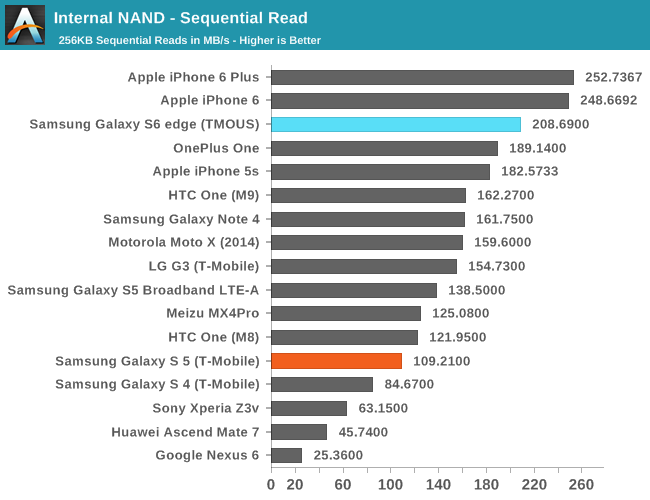
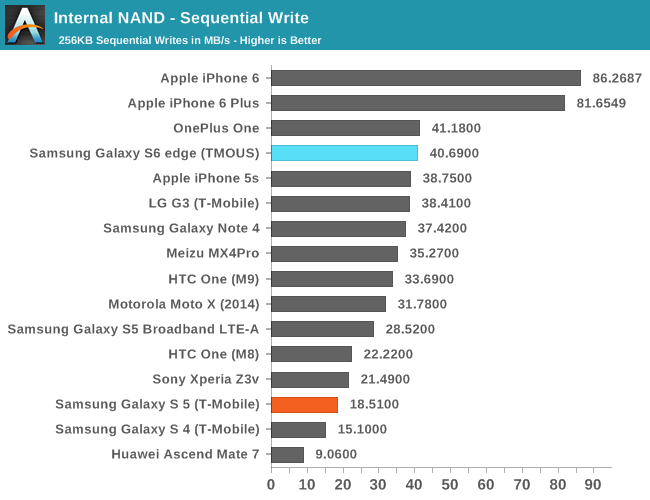
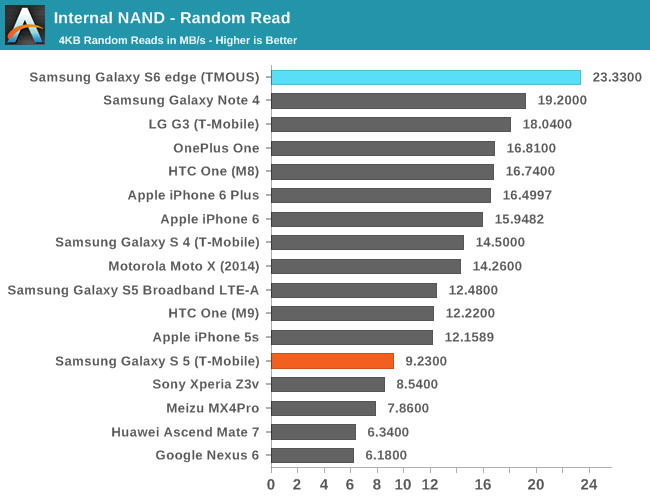
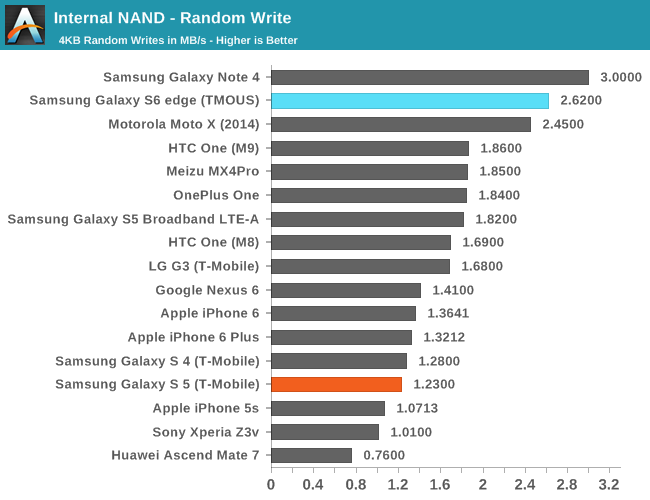
The Galaxy S6 performs rather impressively in our standard storage test, but not as fast as one might have hoped. This is due to the nature of the Androbench 3.6 test, which only tests a single IO thread, which won’t use the UFS storage of the Galaxy S6 to its full extent. In order to see the kind of difference that UFS really makes, I ran the same test again on Androbench 4.x, which does support multiple IO threads. However, as our iOS storage test and Androbench 3.6 don’t support more than a single IO thread we will continue to present both results for now.
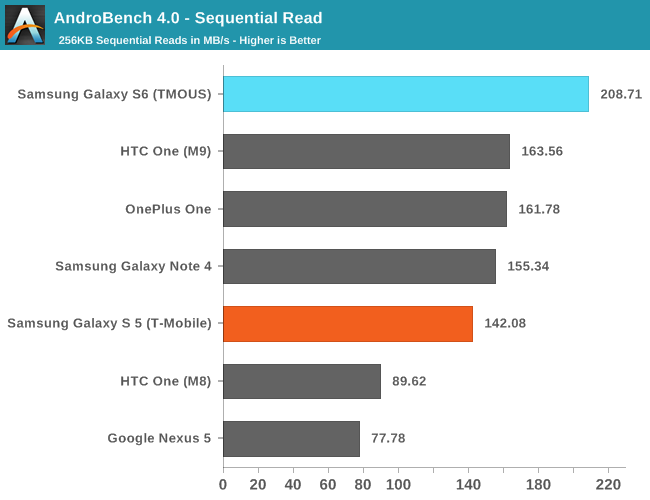
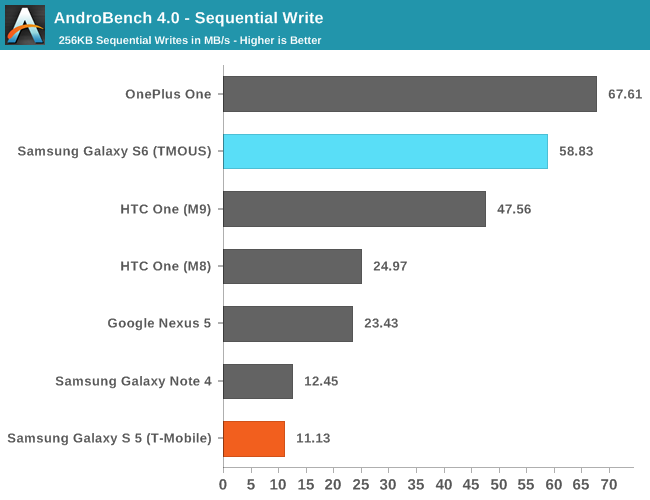
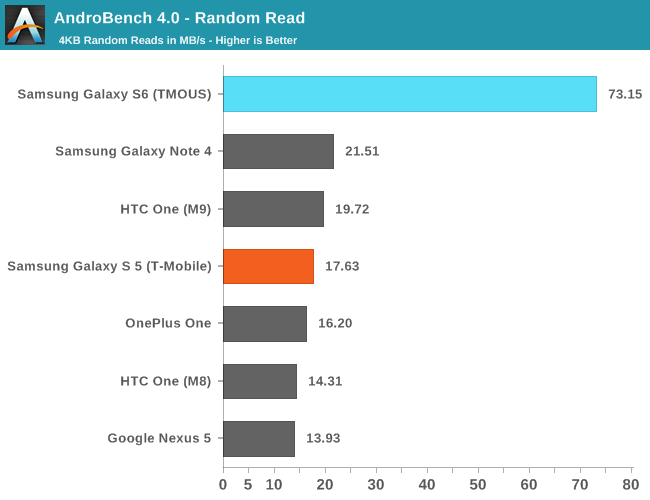
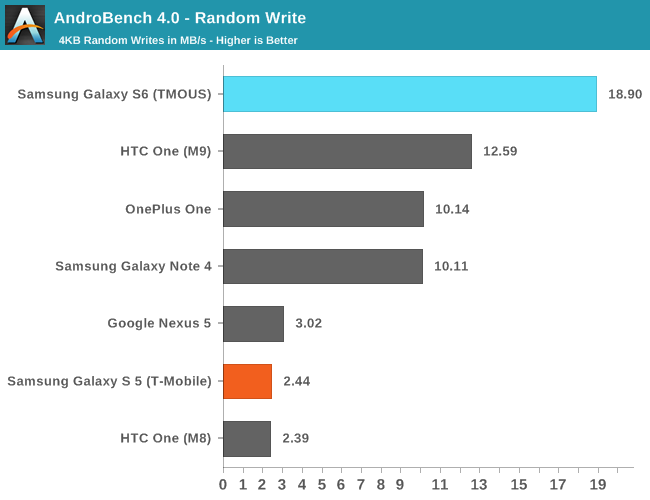
Overall, there are some immense benefits in storage performance here, especially in random IO performance. The Galaxy S6 has some of the fastest storage available in a phone today as far as I can tell given that this is basically a pure MLC solution, and shouldn’t have any real issue with storage performance holding back the rest of the phone over the course of 1-3 years as long as a reasonable amount of free space is kept to allow efficient storage management.


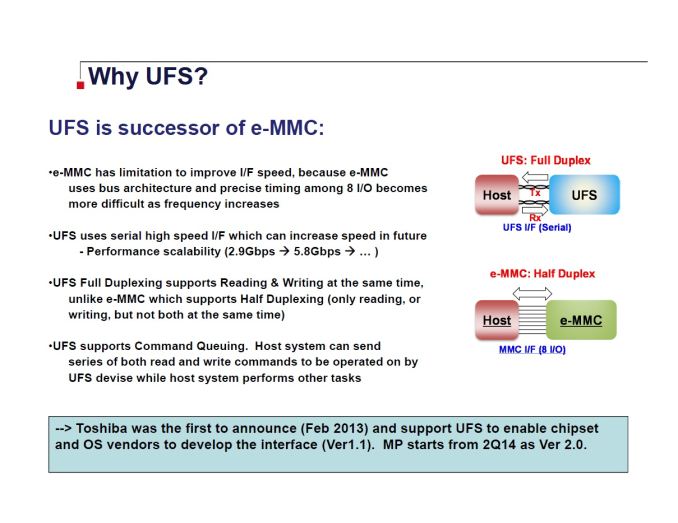








306 Comments
View All Comments
chizow - Saturday, April 18, 2015 - link
Yep exactly, I spend enough time tweaking my PC and at least it provides me proper tools to do so. After a few months with the S4 I just realized it wasn't worth it as the awful battery life and bloats OS made me want to just keep it in my pocket for fear of running out of juice when I actually needed it for phone functions.akdj - Sunday, April 26, 2015 - link
I'm ambidextrous. Use the 6+(personally) & Note 4 (family business of two decades). To be fair with your assessment the iPhone 5 sucked battery just as quick as the S4. At the time, comparable flagships for six months. 5S remedied it with iOS 7, but nothing like iOS 8 and the 6+'s battery size. It's physics and I'm with ya, not arguing. Just my two cents as my Note 4 with 5.0.1 is nearly identical to my 6+ with iOS 8.3 at the end of a 14-16 hour work and family day with similar usage shows similar reserves. Easily 50%. Usually high sixtiesThe memory leaks of yesterday and more granular control of apps and their background abilities on Amdroid (and the new core framework of 5.0), it's distribution of RAM (compression) and raw speed of the NAND makes the new generations of Android feel like iOS. Seriously. It's rare I run into less than 60fps manipulating the UI. And I use third party launcher Nova or Google. Samsung's stock browser is now not only capable but 'fast' and the displays have come a really REALLY LONG way since your S4. They're cool. Stop in and play with the hiDPI models like the S6 and Note 4. The latter of which hauls ass. And looking at these results, the S6 smokes it!
Across the board! And like us iOS dorks, Android's finally got a 128GB on board storage option. I'm as die hard SD card user as there is. I've got a Samsung Pro micro SD that just came out, & it screams! Awesome to pack with media and the like. But then again, I had two choices. White or black. 32 or 32GB. Even the fastest 64GB CF cards are over $200 to get to ½ the speed the S6's internals are reading and writing. And removable storage is prone to failure by user fault than non accessible OEM supplied 'system' optimized storage.
This latest batch of iOS and Android flagships have seen a significant increase in the internal read/write performance. Anyone that used or is using HDDs and have switched to an SSD knows the difference in perceived speed. It's the same on a phone when they've increased as much as they managed to in the past two years.
Especially this round. Note 4. The iPhone 6/6+. And now the king, look at those speeds on the S6. Those are insane and with the faster SoC, RAM (DDR4) and 'storage' I just talked about, along with the lollipop update and it's corresponding (massive) energy savings I've seen makes these 'phones' over the past ten months faster than computers we were using just five years ago. With higher resolution displays. Faster internet than even possible in most places then, wired! & we're getting those speeds on LTE! Wireless cell speed, increased horsepower, refined OS and leaps and bounds of improvements to AMOLED technology have made for a really tough decision which platform to go with. I'm still partial to iOS but only because of its integration and aggregation with OS X, my OS of choice. While I also use Win 8.1 and enjoy it ...neither system welcomes my browser of choice for nearly a decade. Chrome. Now 'Google Apps' it 'takes over' your computer. OS X or Windows, slow as molasses and it's a resource hog! Never thought I'd see the day IE and Safari would be my first choice(s).
Sorry to ramble. Just a view from someone not as responsible as yourself (I've no self control and can't decide between which, so both) and having continued ownership of both platforms since you switched, I'm floored by the improvements to Android, and their associated flagships. The displays are unbelievable when watching movies. Just awesome. Hard to explain how immersive a flick is on a 1440p 5.7" display with a killer set of cans ;)
Onsager - Friday, April 17, 2015 - link
Well written article, however given the few negatives, and very notable benchmarks, I am surprised it didn't receive a 'recommended' badge. The Exynos 7420 Soc itself deserves an award. In fact, numerous statements in the article certainly distinguish this phone as the current class of the field. 'What's a phone gotta do...'halcyonmax - Friday, April 17, 2015 - link
couldn't agree more.gnx - Friday, April 17, 2015 - link
+1Peichen - Saturday, April 18, 2015 - link
Is it necessary? The conclusion already states this is the best Android phone out right now.Onsager - Saturday, April 18, 2015 - link
By that rationale, no awards are ever necessary.akdj - Sunday, April 26, 2015 - link
That's kinda what I concluded. Awards? Who GAS? Hey quite honestly says this is hands down the Android 'king of the hill' (my quote) several times. Camera. Check. Display check. SoC - Yep, Whole page devoted to it eating the rest of the field for lunch. The only silicon that competes with it right now is the A8, Apple's second generation 64bit bad ass.Kinda cool Sammy did what they did with Exynos when the SD810 heat/throttling came to light. Good for them but I think I must've read a different article than you. This isn't a site for trophies and ribbons. And you don't have to read between lines
He actually says this is the BEST Android on the market and perhaps best overall phone. There's areas iOS best Android and vice versa. It's tough to say ones better than the other with 'numbers' ratings or some sort of star system. Bette to say it with words as the author (Josh? I'm sorry bud. Too lazy to look;)) has dome. It's right above this section.
It's called
"Final Words"
Babios - Friday, April 17, 2015 - link
I just had a hands on with both phones for more that an hour. Nice performance but too expensive for android phones. I am disappointed from a 1000€ phone (no sd, single sim, single speaker) and I can not feel it as a premium for that price range.You can buy a cheaper android phone that can cover your needs 99% with the 1/3 of the “Edge” price. S6 can score 70000 in Antutu but mine with 40000 is super fast in every game - application I have used.
Apple became cheaper that Samsung thats the news !!!!
magreen - Friday, April 17, 2015 - link
"As a reminder, power scales quadratically with voltage, so a drop from 1287.50mV to 1056.25mV as seen in the worst bin 1.9GHz A57 frequency should for example result in a massive 48% drop in dynamic power."It's a 33% drop in dynamic power, isnt' it?
(1287.5^2 - 1056.25^2) / 1287.5^2 = 0.327.
(The 48% number would be how much more power the higher voltage part uses than the lower voltage part, which is not the power drop.)